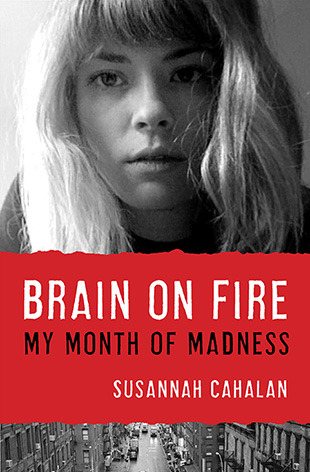What does it feel like to go insane and not know why? In her memoir, Brain on Fire: My Month of Madness, author Susannah Cahalan describes what it is like in terrifying detail: “My body continued to stiffen as I inhaled repeatedly, with no exhale. Blood and foam began to spurt out of my mouth through clenched teeth.… This moment, my first serious blackout, marked the line between sanity and insanity. Though I would have moments of lucidity over the coming weeks, I would never again be the same person. This was the start of the dark period of my illness, as I began an existence in purgatory between the real world and a cloudy, fictitious realm made up of hallucinations and paranoia.”
At the time, Cahalan was twenty-four years old and working at the New York Post. Having climbed up slowly from an intern to a full-time news reporter, she was young, ambitious, and known for being confident and professional. Cahalan’s future was bright when she was suddenly struck by an affliction that stumped her, her family, and most medical professionals.
Cahalan uses her reporter’s skills to knit together the incidents surrounding her downward spiral. She tries to piece together a time about which she has little or no recollection. Her few existing memories range from fuzzy half-truths to full-out hallucinations. She recounts the experience of paging through her father’s diary like she was reading about a stranger.
Cahalan deftly weaves together intimate moments with intricate medical explanations of her condition, which at times reads like a detective story. By meticulously retracing her own footsteps through seizures, rampant paranoia, and delusions, Cahalan engages with her passion for research. She walks readers through her various misdiagnoses — including one doctor who insisted that alcoholism was to blame — and eventually reaches the point of an accurate diagnosis, treatment, and recovery.
Brain on Fire makes for a gripping read. As Cahalan describes in her introduction, the book is “a journalist’s inquiry into that deepest part of the self — personality, memory, identity — in an attempt to pick up and understand the pieces left behind.”
After interviewing a host of doctors and experts around the globe, Cahalan was able to report every aspect of her illness and treatments — including her own brain surgery — in detailed yet accessible terms. “With a scalpel, Dr. Doyle made an S-shape incision, four centimeters from the midline of the scalp over the right frontal region. The arm of the S extended just behind my hairline,” she writes. “He parted the skin with a sharp blade and gripped each side with retractors.… The whole procedure took four hours.”
Divided into three parts, the first section of Brain on Fire leads us from the murky confusion of Cahalan’s initial seizures and bouts of paranoia through the fragmented and reconstructed memories of her time in the hospital. Cahalan writes with flagrant honesty, piecing together hospital records, her parents’ shared diary, video footage from her time in a monitored epilepsy ward, and her own disjointed scribblings. This timeline of events is combined with the narrative occurring within Cahalan’s own distorted mind, which is set apart in italics to differentiate the two realities.
During these highly personal accounts, Cahalan describes her hallucinations and paranoia. At one point, she obsessively searches her boyfriend’s apartment for proof of his alleged infidelity. We feel her panic and confusion escalate as the book progresses, and Cahalan struggles to maintain a sense of her authentic identity. “No one wants to think of herself as a monster,” she writes.
As Cahalan’s situation worsens, the heroic Dr. Souhel Najjar arrives on the scene. After seemingly endless tests using the highest technology, Dr. Najjar is able to solve the puzzle. Cahalan is diagnosed with a little-known, recently discovered autoimmune disease called anti-NMDAR encephalitis.
“Her brain is on fire,” Dr. Najjar tells Cahalan’s parents. “Her brain is under attack by her own body.”
Cahalan goes on to detail her bumpy road to recovery, in which she deals with the burden of “survivor’s guilt” — a kind of post-traumatic stress disorder — and a fear of relapse that is said to occur in twenty percent of cases. It is frightening how little is known about this rare disease, and as Cahalan writes, “It just begged the question: If it took so long for one of the best hospitals in the world to get to this step, how many other people were going untreated, diagnosed with a mental illness or condemned to a life in a nursing home or a psychiatric ward?”
Aside from being an excellently written memoir, Brain on Fire is also a valuable case study of a rare neurological disease. Cahalan is the 217th person to ever be diagnosed with anti-NMDAR encephalitis, and her diagnosis occurred just two years after the disease was discovered. Brain on Fire and “My Mysterious Lost Month of Madness,” the article from which the book emerged, have been instrumental in helping more people receive a correct diagnoses and treatment for the disease.
Cahalan’s work raises many questions about the root of “madness” and how easily we sling the term about. For those struggling to make sense of a disease like hers, Brain on Fire offers guidance and understanding. For the rest of us, it’s a fascinating and well-told cautionary tale.
Jo Magpie Jo Magpie is a freelance journalist, travel writer, and long-term wanderer currently based in Granada, Spain. Blog: agirlandherthumb.wordpress.com
- Follow us on Twitter: @inthefray
- Comment on stories or like us on Facebook
- Subscribe to our free email newsletter
- Send us your writing, photography, or artwork
- Republish our Creative Commons-licensed content


